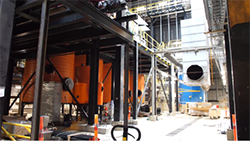
Sustainable waste management is a key part of any green business strategy. An international company based in Sweden has embarked on a LIFE project that shows how reducing the waste from your business can protect the environment while boosting profits.
Waste that cannot be recycled or landfilled is usually burned in incineration plants, releasing toxins into the atmosphere. LIFE HaloSep has come up with a way to treat and recycle some of the hazardous waste coming from these plants, creating a circular economy in the process.
The EU has been working hard to ensure that hazardous waste is dealt with in the safest way possible. Its Sixth and Seventh Environment Action Programmes aimed to ensure that economic growth did not lead to more waste. Also, the EU’s Waste Framework Directive expects Member States to recycle 50% of their municipal waste and 70% of their construction waste. And earlier this year, the European Commission adopted a new Circular Economy Action Plan as part of the European Green Deal. This plan encourages sustainable consumption so that the resources used are kept in the economy for as long as possible.
Staffan Svensson, President of HaloSep AB and board member of the LIFE HaloSep project, is a firm believer in the circular economy. In an interview with LIFE, he explains how the results of this project could be a game-changer for waste management in Europe.
Tell us about LIFE HaloSep
We are looking at the residues coming from these waste incineration plants, one of which is called fly ash. This fly ash is classified as hazardous waste, as it contains chlorides and heavy metals. It is therefore sent to special hazardous waste landfills. In Sweden alone, around 150 000 tonnes of fly ash is generated each year. Most of it is transported a long distance to a disused limestone quarry in Norway and some to discontinued salt mines in Germany. It is then buried underground and forgotten about. This is anything but sustainable!
What is your main goal?
There is an urgent need to reduce this hazardous waste and to extract its reusable parts. Doing this would reduce, or even eliminate the amounts going to landfill. Our goal is therefore to create a circular economy out of this waste stream. This is the first time a project has done this on an industrial scale.
My advice to other companies thinking about greening their business would be to partner with dedicated experts in the field. Also, having a patient partner like LIFE that supports you throughout the process is vital. It pays off in the longer term.
What actions have you taken to achieve this goal?
We have spent the last 18 months building the HaloSep process at Vestforbrænding - one of Denmark’s largest waste-to-energy plants. This facility will allow us to derive non-hazardous ash and saltwater from the fly ash that is safe to release into the environment. Furthermore, the metal in the ash can be recycled and the salt can be used for de-icing roads.
We expect to see 40% less fly ash going to landfill and hope to stop the need for cleaning the scrubber liquid, which up until now, has been used to remove pollutants from the ash. This would reduce costs by up to 60% and lower the need for transporting the ash which reduces emissions. The process would also use fewer chemicals than previously.
What stage are you at now?
We have finished building the facility. Over the summer we tested its components without adding any fluids or ash. In the coming few weeks, we will be carrying out a complete test. Once this is done, we are ready to go and this will serve as a stepping-stone for our future plans.
What are these future plans?
Once the HaloSep process facility is up and running, we will bring the technology to the market. We also plan on opening a research facility in Sweden. This will allow us to further develop the technology and help us have a final product for other energy recovery facilities to use.
We already have customers in Scandinavia, in other parts of Europe and in Asia that want us to build more HaloSep facilities now! I’m convinced that in 2021, we will have several commercial plants located at our customers’ sites.
Details
- Publication date
- 23 September 2020
- Author
- Executive Agency for Small and Medium-sized Enterprises
